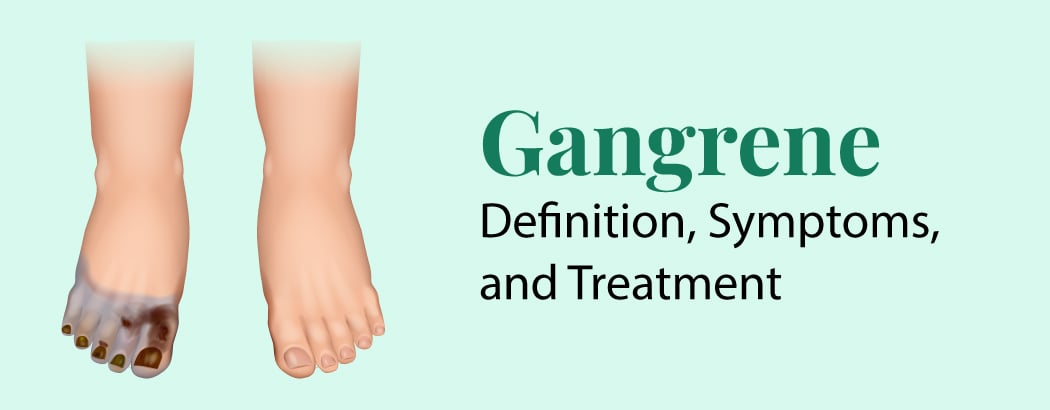Gangrene – Definition, Symptoms, and Treatment
June 21, 2024

Overview
Gangrene is the death of bodily tissue brought on by a severe bacterial infection or a reduction in blood supply. The arms and legs, especially the toes and fingers, are frequently affected by gangrene. It can also happen in the body’s internal organs, including the gallbladder, and muscles. Antibiotics, oxygen therapy, and surgery to remove dead tissue and restore blood flow are among possible treatments for gangrene. The chance of recovery from gangrene improves with prompt diagnosis and treatment.
Contents
What is Gangrene?
A major illness called gangrene causes a bodily component to start decomposing. A common description of this process is necrosis or tissue death. A significant lack of blood flow to an extremity of the body, such as the hands, feet, nose, or ears, or an overpowering infection can result in gangrene.
Sepsis (blood infection) or total loss of the afflicted extremity are possible outcomes of gangrene. If left untreated, it can become life-threatening very quickly.
Symptoms of Gangrene
Depending on the kind and intensity, gangrene can present with a variety of symptoms and clinical indications. Important gangrene warning indicators include:
- Skin Changes: The colour, texture, and appearance of gangrenous tissue frequently show noticeable changes. In cases of dry gangrene, it may seem light or blueish-black and in cases of wet or gas gangrene, it may appear dark red or greenish-black.
- Pain: Gangrenous tissue can cause pain, varying from a little soreness to an intense, stabbing ache. But occasionally, especially with diabetic neuropathy, people may feel less sensitive or numb in the afflicted area.
- Blisters and Ulceration: Blisters filled with pus or foul-smelling fluid may grow on the skin in wet gangrene. These blisters may burst and leave open sores or ulcers. These ulcers might be prone to infection and leak fluid.
- Bad Odour: Bacterial infection and tissue degradation in gangrene can produce an unpleasant stench that is typically compared to rotten or putrid. The smell is worse when the gangrene is damp.
- Lack of Sensation: People who have gangrene, particularly those who have diabetes or vascular disease, may feel numbness or loss of feeling in the affected area.
- Swelling and Tenderness: Inflammation and tissue necrosis can cause gangrenous regions to swell, feel painful to the touch, and become warm. Over the afflicted region, the skin may feel stretched out and constricted.
The Gangrene Diagnosis
Diagnosis of pheochromocytoma will include the following:
- Lab Examination of a Sample Tissue: To identify the type of bacteria present, a microscope may be used to analyze a sample of fluid or tissue removed from the afflicted body part.
- Blood Examinations: A gangrene infection may be indicated by an abnormally elevated white blood cell count. To aid in the diagnosis, medical professionals can also reheat a blood sample to promote the development of germs.
- Imaging in Medicine: When identifying the progression of gangrene in your internal tissues, several imaging modalities might be useful. These examinations could consist of:
- CT scans
- MRI scans
- CT scans
Treatment for Gangrene
Gangrene is often treated with one or more of the following techniques:
- Surgical Debridement: To stop gangrene from spreading and to speed up the healing of wounds, surgical debridement entails removing diseased or dead tissue. As much healthy tissue as possible is preserved during this surgery, with necrotic or diseased portions removed.
- Antibiotic Therapy: In situations of wet or gas gangrene, antibiotics are frequently administered to treat bacterial infections linked to gangrene. Intravenous use of broad-spectrum antibiotics can target a variety of microorganisms and avoid systemic illness.
- Dressing Changes: Managing gangrenous wounds, encouraging the growth of granulation tissue, and preventing infection all depend on proper wound care and dressing changes. In order to keep the wound moist and promote healing, wounds can be cleansed, debrided, and bandaged appropriately.
- Amputation: To remove the diseased limb or finger and stop the infection from spreading further, a surgical amputation may be required in severe cases of gangrene when there has been considerable and irreparable tissue destruction.
- Revascularization procedures: Angioplasty, stenting, or bypass surgery are examples of revascularization operations that may be carried out in situations of ischemia or arterial gangrene in order to salvage viable tissue and restore blood flow to the damaged area.
- Hyperbaric Oxygen Therapy: Hyperbaric Oxygen Therapy is a technique that enhances oxygen delivery to tissues and speeds up the healing of wounds by inhaling pure oxygen within a pressurized chamber. For some forms of gangrene, such as diabetic foot ulcers or resistant wounds, hyperbaric oxygen therapy may be utilized as a secondary treatment.
Conclusion
Gangrene is a serious skin ailment and is typified by tissue death brought on by a decreased blood flow or bacterial infection. For early diagnosis and treatment, it is essential to comprehend the kinds, causes, warning signals, and available treatments for gangrene. Even though gangrene can be fatal if ignored, complications can be avoided and results can be improved with prompt medical attention. Surgical debridement, antimicrobial therapy, revascularization techniques, hyperbaric oxygen therapy, wound care, and, in extreme circumstances, amputation are among possible treatment modalities.
Frequently Asked Questions
1. Who is susceptible to gangrene?
Gangrene is more common in those with diabetes, peripheral artery disease, and Raynaud’s illness. Gangrene can also result from burns, wounds, dog bites, frostbite, and skin infections.
2. What is the appearance of gangrene?
Skin color changes are a clear indicator of gangrene. Due to insufficient blood supply, your skin may seem pale at first. Then, though, it turns scarlet. After that, it can become brown and eventually greenish-black. Additionally, your skin could seem bloated and may have obvious blisters or sores.
3. How is gangrene different from necrosis?
Anywhere in your body, cell death is referred to as necrosis. A kind of necrosis called gangrene develops when a portion of the body loses blood supply, causing the tissues there to perish.






